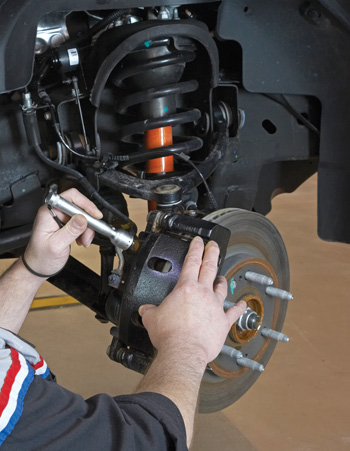Brake pads often get a bad rap for causing such problems as noise and pedal pulsations. Worn brake pads obviously need to be replaced when the friction linings are worn down to minimum thickness (typically 1/8 inch or less), but worn pads are seldom the primary cause of brake noise or pedal pulsations.
 Brake noise occurs when there is undampened movement or play between the pads and calipers.
Brake noise occurs when there is undampened movement or play between the pads and calipers.
Movement allows vibration, which causes squeals and rattles. Brake noise can also occur if the pads are not held securely in the calipers, or the noise shims or anti-rattle clips for the pads are missing, severely corroded or installed incorrectly.
Brake pad mounting hardware should always be inspected and replaced as needed when the pads are changed. Many replacement pads come with preinstalled shims or internally molded shims to dampen vibrations and noise. Applying high-temperature brake grease or a noise suppression compound to the backs of the pads also can help dampen noise. Noise also can be minimized by spraying the rotors with an aerosol break-in compound that controls noise while a new set of pads are breaking in.
The type of friction material in the pads can also affect noise. Ceramic friction materials are usually softer and quieter than semi-metallic friction materials, and the latest generation of low-copper/ceramic pads are probably the quietest ever. The design of the pads can also dampen or amplify noise. Higher-grade brake pads typically have slots and chamfers to help dampen noise. Chamfering the edges of the pads concentrates the surface load more or relocates it slightly to dampen noise-producing vibrations.
Some premium pads also have special surface coatings such as titanium dioxide, copper, graphite, etc. to help break-in the linings and dampen noise during the first few hundred miles of operation.
Many premium pads are “preburnished” to eliminate many of the problems that can occur if the pads are not broken in properly. When brake linings are manufactured, the resins that bind the ingredients together may not be fully cured. When the linings are installed on a vehicle, the heat produced by normal braking bakes the linings and cooks out the residual chemicals from the resins to improve the friction characteristics of the lining. But if the vehicle owner stomps on the brakes too hard during this initial break-in period and overheats the brakes, it can “glaze” the linings, which will cause noise and performance problems. So to eliminate the break-in period, many pads are now fully heat-cure (burnished) at the factory.
Premium-grade pads also use better materials than economy grade pads, so they usually run quieter, last longer and provide superior braking performance. Premium pads cost a more than standard or economy pads. But when you consider the cost of the pads as a part of a complete brake job (pads, rotors, calipers, labor, etc.), the extra cost is insignificant — and for professional customers, the extra cost is well worth it because it means fewer comebacks.
Brake pedal vibrations are usually caused by variations in rotor thickness, not the type of friction material in the pads or movement between the pads and calipers. Uneven rotor wear can be caused by rotor runout, variations in the harness of the iron in the rotors, or by hard spots that develop in the rotors as a result of high braking temperatures. Replacing the pads won’t cure a pedal pulsation problem because the real problem is the rotors, not the pads. The rotors need to be replaced.








